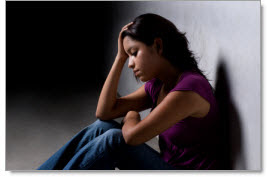Age is not a factor when it comes to psychiatric disorder emergence, and the clinical communities of the world reliably agree on this. For sure though, when it comes to assessment, evaluation, intervention strategies and particularly medication management, children and even adolescents should not be considered “little” adults.
For mood disorders, there is the nature vs. nurture controversy — raising the question as to what extent depression in children is biological, environmental or both. Also, co-occurring disorders in children are the rule rather than the exception, so distilling a veritable hodge-podge of symptoms down to something clear-cut can be quite a challenge.
 I’ve identified 2 key dimensions when it comes to evaluating children and adolescents for depression, together with how to proceed from a treatment perspective. Before addressing these, I want to mention the importance of determining depression in youth based on age. Depression is most common in teens, usually at ages 15-18 years — possibly as early as age 14. Young people with pronounced melancholia and anhedonia in the 10-12 year age range does occur, but very rarely. Unhappy 6 or 7 year olds tend to be more anxious than depressed — often because their lives have become more complicated for any number of primarily environmental reasons.
I’ve identified 2 key dimensions when it comes to evaluating children and adolescents for depression, together with how to proceed from a treatment perspective. Before addressing these, I want to mention the importance of determining depression in youth based on age. Depression is most common in teens, usually at ages 15-18 years — possibly as early as age 14. Young people with pronounced melancholia and anhedonia in the 10-12 year age range does occur, but very rarely. Unhappy 6 or 7 year olds tend to be more anxious than depressed — often because their lives have become more complicated for any number of primarily environmental reasons.
2 Key Dimensions to Look For in Depressed Youth
1. Dispirited Children and Adolescents.
Although dispirited children and adolescents may meet broad criteria for depression, largely their unhappiness and disturbed mood are a result of distressing life experiences: rotten schools, quarrelling families, poor peer relationships and poverty. They present more as “demoralized”rather than clinically depressed and will talk about how unhappy and difficult their lives are.
2. True Clinically Depressed Youth.
This presentation has a clearly defined episodic onset which represents a change from prior functioning. Manifestations include:
- Slowed mind and slowed body (psychomotor retardation)
- Attention and concentration problems
- Diurnal mood variation
- Pronounced anhedonia (inability to experience pleasure)
As for change in functioning, parents will report that the child is moving more slowly and sitting on the couch, for example, for long periods of time. Attention capacity and concentration are markedly diminished compared to previous levels, making it harder for them to read, in particular. Also, mood tends to be worse in the morning for clinically depressed youth, with gradual improvement throughout the day. This often leads them to stay up late in an attempt to capture an improved mood for a longer period of time — a phenomenon known as “phase-shifting.” These kids aren’t just unhappy they’re miserable, and will say so.
So how do you sort out whether a child meeting criteria for depression is dispirited or clinically depressed? Start by asking your young patient about an upcoming fun event or something he recently did that he found enjoyable. The dispirited child or adolescent will light up and display obvious signs of joy in anticipation of the upcoming fun to be had, or will comment on something he already enjoyed with enthusiasm for wanting to do it again. On the other hand, the clinically depressed teen might say this, “I don’t believe I’m going to be doing anything fun and the trip we took to the mountains didn’t cheer me up either.” Then consider the characteristics of dispirited youth versus those who are biologically depressed to help you further at fleshing out your evaluation and diagnosis.
How to Proceed
 Dispirited youth will likely better respond to time-honored problem-solving interventions rather than medication. What they really want and need is someone to talk to, who is committed to helping them manage the situations that cause and perpetuate distress, such as at school or home. Alternatively, a medication trial could easily backfire and dishearten them further, because as these teens figure out that their depressed mood is related to troublesome life circumstances, they’ll conclude: “I’m having it tough, and all I get is this stupid pill.” Mindfulness for teens works very well with dispirited youth, together with building on the teen’s strengths. Don’t focus on shoring up weaknesses as this may have them thinking that they’re damaged, which of course is not the case.
Dispirited youth will likely better respond to time-honored problem-solving interventions rather than medication. What they really want and need is someone to talk to, who is committed to helping them manage the situations that cause and perpetuate distress, such as at school or home. Alternatively, a medication trial could easily backfire and dishearten them further, because as these teens figure out that their depressed mood is related to troublesome life circumstances, they’ll conclude: “I’m having it tough, and all I get is this stupid pill.” Mindfulness for teens works very well with dispirited youth, together with building on the teen’s strengths. Don’t focus on shoring up weaknesses as this may have them thinking that they’re damaged, which of course is not the case.
True clinically depressed youth with melancholia, psychomotor retardation and “phase shifting” tendencies are prime candidates for a medication trial, accompanied by cognitive-behavioral treatment (mindfulness, etc.) as an adjunct. Because there is altered biology at work here, antidepressants can potentially help these children feel brighter, more energetic and experience less doom and gloom. Prozac (fluoxetine) and Lexapro (escitalopram) are both FDA-approved for use in children and teens, but keep in mind that an FDA indication is mostly a governmental artifact and doesn’t speak to other evidence-based antidepressants that work every bit as well.
The number of children experiencing true clinical depression is rather small when compared to the number of kids who are dispirited and demoralized, so distinguishing between the two is very important in terms of treatment directions and outcomes.
Attribution Statement:
Joe Wegmann is a licensed pharmacist & clinical social worker has presented psychopharmacology seminars to over 10,000 healthcare professionals in 46 states, and maintains an active psychotherapy practice specializing in the treatment of depression and anxiety. He is the author of Psychopharmacology: Straight Talk on Mental Health Medications, published by PESI, Inc.
To learn more about Joe’s programs, visit the Programs section of this website or contribute a question for Joe to answer in a future article: joe@thepharmatherapist.com.